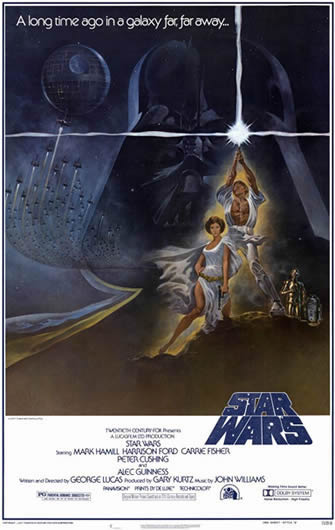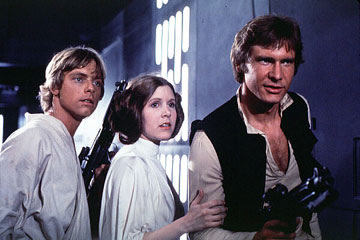The Original Trilogy

Original 1977 Movie Poster
In 1971, Universal Studios agreed to make American Graffiti and Star Wars in a two-picture contract, although Star Wars was later rejected in its early concept stages. American Graffiti was completed in 1973 and, a few months later, Lucas wrote a short summary called "The Journal of the Whills", which told the tale of the training of apprentice C.J. Thorpe as a "Jedi-Bendu" space commando by the legendary Mace Windy. Frustrated that his story was too difficult to understand, Lucas then wrote a 13-page treatment called The Star Wars, which was a loose remake of Akira Kurosawa's The Hidden Fortress. By 1974, he had expanded the treatment into a rough draft screenplay, adding elements such as the Sith, the Death Star, and a protagonist named Annikin Starkiller. For the second draft, Lucas made heavy simplifications, and also introduced the young hero on a farm as Luke Skywalker. Anakin became Luke's father, a wise Jedi knight. "The Force" was also introduced as a supernatural power. The next draft removed the father character and replaced him with a substitute named Ben Kenobi, and in 1976 a fourth draft had been prepared for principal photography. The film was titled Adventures of Luke Starkiller, as taken from the Journal of the Whills, Saga I: The Star Wars. During production, Lucas changed Luke's name to Skywalker and altered the title to simply The Star Wars and finally Star Wars.
At that point, Lucas was not expecting the film to become part of a series. The fourth draft of the script underwent subtle changes that made it more satisfying as a self-contained film, ending with the destruction of the Empire itself by way of destroying the Death Star. However, Lucas had previously conceived of the film as the first in a series of adventures. Later, he realised the film would not in fact be the first in the sequence, but a film in the second trilogy in the saga. This is stated explicitly in George Lucas' preface to the 1994 reissue of Splinter of the Mind's Eye:
It wasn't long after I began writing Star Wars that I realized the story was more than a single film could hold. As the saga of the Skywalkers and Jedi Knights unfolded, I began to see it as a tale that could take at least nine films to tell – three trilogies – and I realized, in making my way through the back story and after story, that I was really setting out to write the middle story.
The second draft contained a teaser for a never-made sequel about "The Princess of Ondos," and by the time of the third draft some months later Lucas had negotiated a contract that gave him rights to make two sequels. Not long after, Lucas met with author Alan Dean Foster, and hired him to write these two sequels as novels. The intention was that if Star Wars were successful, Lucas could adapt the novels into screenplays. He had also by that point developed a fairly elaborate backstory to aid his writing process.
When Star Wars proved successful, Lucas decided to use the film as the basis for an elaborate serial, although at one point he considered walking away from the series altogether.However, Lucas wanted to create an independent filmmaking center – what would become Skywalker Ranch – and saw an opportunity to use the series as a financing agent. Alan Dean Foster had already begun writing the first sequel novel, but Lucas decided to abandon his plan to adapt Foster's work; the book was released as Splinter of the Mind's Eye the following year. At first Lucas envisioned a series of films with no set number of entries, like the James Bond series. In an interview with Rolling Stone in August 1977, he said that he wanted his friends to each take a turn at directing the films and giving unique interpretations on the series. He also said that the backstory in which Darth Vader turns to the dark side, kills Luke's father and fights Ben Kenobi on a volcano as the Galactic Republic falls would make an excellent sequel.
Later that year, Lucas hired science fiction author Leigh Brackett to write Star Wars II with him. They held story conferences and, by late November 1977, Lucas had produced a handwritten treatment called The Empire Strikes Back. The treatment is very similar to the final film, except that Darth Vader does not reveal he is Luke's father. In the first draft that Brackett would write from this, Luke's father appears as a ghost to instruct Luke.
Brackett finished her first draft in early 1978; Lucas has said he was disappointed with it, but before he could discuss it with her, she died of cancer. With no writer available, Lucas had to write his next draft himself. It was this draft in which Lucas first made use of the "Episode" numbering for the films; Empire Strikes Back was listed as Episode II. As Michael Kaminski argues in The Secret History of Star Wars, the disappointment with the first draft probably made Lucas consider different directions in which to take the story. He made use of a new plot twist: Darth Vader claims to be Luke's father. According to Lucas, he found this draft enjoyable to write, as opposed to the year-long struggles writing the first film, and quickly wrote two more drafts, both in April 1978. He also took the script to a darker extreme by having Han Solo imprisoned in carbonite and left in limbo.
This new story point of Darth Vader being Luke's father had drastic effects on the series. Michael Kaminski argues in his book that it is unlikely that the plot point had ever seriously been considered or even conceived of before 1978, and that the first film was clearly operating under an alternate storyline where Vader was separate from Luke's father;there is not a single reference to this plot point before 1978. After writing the second and third drafts of Empire Strikes Back in which the point was introduced, Lucas reviewed the new backstory he had created: Anakin Skywalker was Ben Kenobi's brilliant student and had a child named Luke, but was swayed to the dark side by Emperor Palpatine (who became a Sith and not simply a politician). Anakin battled Ben Kenobi on the site of a volcano and was wounded, but then resurrected as Darth Vader. Meanwhile Kenobi hid Luke on Tatooine while the Republic became the Empire and Vader systematically hunted down and killed the Jedi.
The Characters

The original cast of Star Wars.
- Mark Hamill as Luke Skywalker: Skywalker is a young man who was raised by his aunt and uncle on the remote, desert world Tatooine and who dreams of something greater than his current position in life.
- Harrison Ford as Han Solo: Solo is a self-absorbed smuggler whom Obi-Wan and Luke meet in a cantina and with whom they later travel. Solo, who owns the ship Millennium Falcon, is good friends with Chewbacca, the ship's co-pilot.
- Carrie Fisher as Princess Leia Organa: Organa is a member of the Imperial Senate and a leader of the Rebel Alliance. She plans to use the stolen Death Star plans to find the station's weakness.
- Alec Guinness as Obi-Wan "Ben" Kenobi: Kenobi is an aging man who served as a Jedi Knight and then Jedi Master during the Clone Wars. Early in the film, Kenobi introduces Luke to the Force.
- David Prowse as Darth Vader: Vader is a Dark Lord of the Sith, and a prominent figure in the Galactic Empire who hopes to destroy the Rebel Alliance. He was voiced by James Earl Jones.
- Peter Cushing as Grand Moff Tarkin: Tarkin is the commander of the Death Star and a Regional Governor. He leads the search for the Rebel Base, hoping to destroy it.
- Anthony Daniels as C-3PO: C-3PO is a protocol and interpreter droid who falls into the hands of Luke Skywalker. He is rarely without his counterpart droid, R2-D2.
- Kenny Baker as R2-D2: R2-D2 is an astromech droid who also falls into the hands of Luke. He is carrying a secret message for Obi-Wan Kenobi.
- Peter Mayhew as Chewbacca: Chewbacca is the Wookiee co-pilot of the Millennium Falcon and a close friend of Han Solo.
- Denis Lawson as Wedge Antilles: Antilles is a starfighter pilot who fights alongside Luke in the Battle of Yavin. In the ending credits, Lawson's first name is misspelled "Dennis".
About the Film
Star Wars is an American epic space opera franchise conceived by George Lucas. The first film in the franchise was originally released on May 25, 1977, by 20th Century Fox, and became a worldwide pop culture phenomenon, followed by two sequels, released at three-year intervals. Sixteen years after the release of the trilogy's final film, the first in a new prequel trilogy of films was released, again released at three-year intervals, with the final film released on May 19, 2005.
Star Wars Setting
The events depicted in Star Wars media take place in a fictional galaxy. Many species of alien creatures (often humanoid) are depicted. Robotic droids are also commonplace and are generally built to serve their owners. Space travel is common, and many planets in the galaxy are members of a Galactic Republic, later reorganized as the Galactic Empire.
One of the prominent elements of Star Wars is the "Force", an omnipresent energy that can be harnessed by those with that ability. It is described in the first produced film as "an energy field created by all living things [that] surrounds us, penetrates us, [and] binds the galaxy together." The Force allows users to perform a variety of supernatural feats (such as telekinesis, clairvoyance, precognition, and mind control) and also can amplify certain physical traits, such as speed and reflexes; these abilities vary between characters and can be improved through training. While the Force can be used for good, it has a dark side that, when pursued, imbues users with hatred, aggression, and malevolence. The six films feature the Jedi, who use the Force for good, and the Sith, who use the dark side for evil in an attempt to take over the galaxy. In the Star Wars Expanded Universe, many dark side users are Dark Jedi rather than Sith, mainly because of the "Rule of Two".
Additional Information
To learn more about Star Wars, read the following online articles:
- Official Star Wars Site:
http://www.starwars.com/ - George Lucas: Mapping the Mythology - http://archives.cnn.com/2002/SHOWBIZ/Movies/05/07/ca.s02.george.lucas/
- The Force Behind Star Wars - http://web.archive.org/web/20080619110633/
http://www.rollingstone.com/ news/story/7330268/ the_force_behind_star_wars
